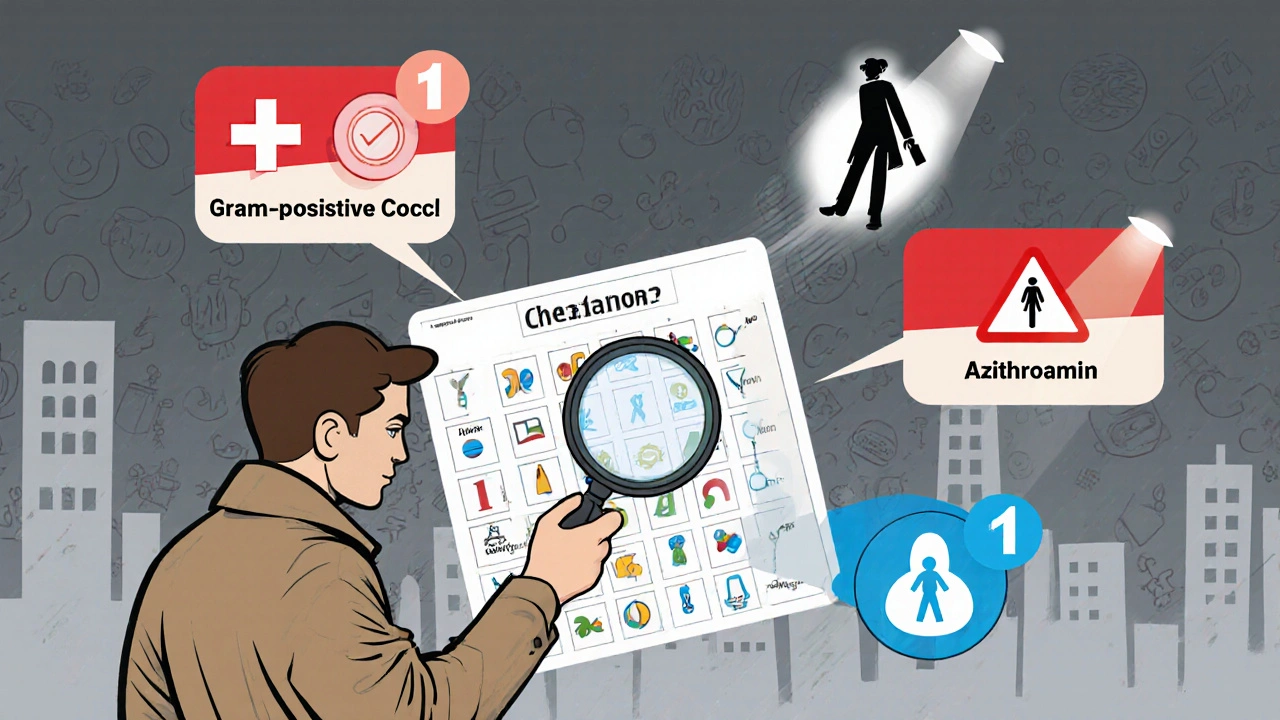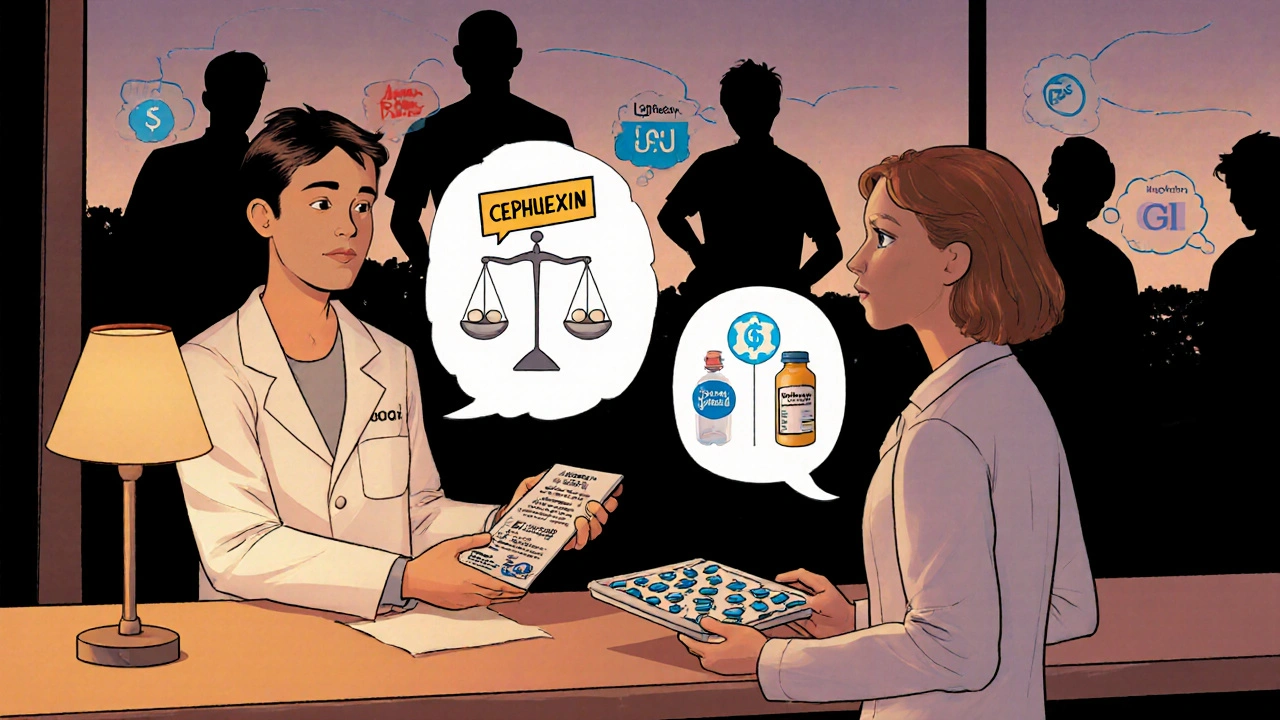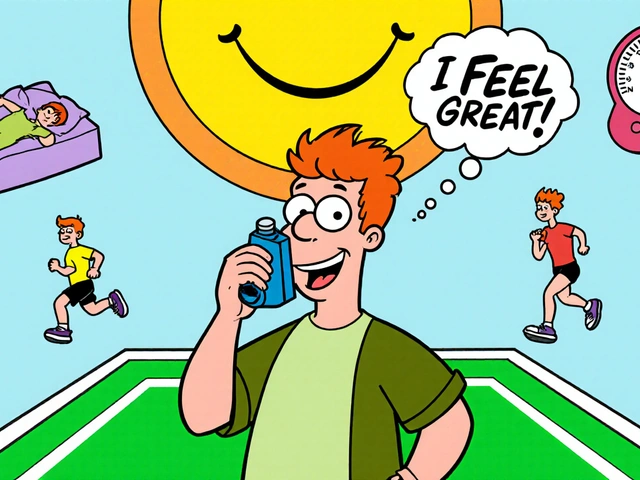Antibiotic Decision Assistant
Find the Best Antibiotic for Your Situation
This tool helps you understand which antibiotic might be best for your specific situation based on infection type, allergies, and health factors. Remember, always follow your healthcare provider's recommendations.
Select options above and click "Find Your Antibiotic" to see your personalized recommendation.
Imagine you’ve got a skin infection or a mild throat sore and your doctor writes you a prescription for Cephalexin. You stare at the name and wonder if there’s a cheaper pill, fewer side effects, or a drug that works better for your particular bug. You’re not alone-patients and caregivers constantly weigh Cephadex against other antibiotics before filling a script.
Key Takeaways
- Cephalexin is a first‑generation cephalosporin best for Gram‑positive skin and soft‑tissue infections.
- Amoxicillin offers broader oral coverage for ear, nose, and throat infections but can trigger more GI upset.
- Azithromycin provides a convenient once‑daily dosing schedule and works well for atypical organisms, though it’s pricier.
- Clindamycin is the go‑to for anaerobic and some resistant skin infections, but it carries a higher risk of C.difficile colitis.
- Doxycycline covers atypical and some tick‑borne illnesses, but it isn’t ideal for children under eight or pregnant women.
What is Cephalexin (Cephadex)?
Cephalexin is a first‑generation cephalosporin antibiotic that works by interfering with bacterial cell‑wall synthesis. It was first approved in the United States in 1979 and quickly became a staple for treating uncomplicated skin, bone, and urinary‑tract infections caused primarily by Gram‑positive bacteria such as Staphylococcus aureus and Streptococcus pyogenes. The brand name Cephadex is a popular US‑market label, but the drug is sold worldwide under many generic names.
Why People Look for Alternatives
Even though Cephalexin is effective, several factors push patients to consider other options:
- Allergy concerns - a subset of patients report a mild rash or cross‑reactivity with penicillin.
- Cost differences - while many insurers cover generic Cephalexin, some plans list a higher co‑pay than for amoxicillin.
- Convenient dosing - Cephalexin is usually taken twice daily; some patients prefer once‑daily regimens.
- Targeted spectrum - infections involving anaerobes, atypical organisms, or resistant strains may need a different class.
Side‑Effect Profile at a Glance
Understanding how Cephalexin’s side effects stack up helps you decide if another drug might feel safer.
| Drug | GI upset (nausea, diarrhea) | Allergic rash | Risk of C.difficile | Special warnings |
|---|---|---|---|---|
| Cephalexin | Low‑moderate (≈10%) | ~5% (more in penicillin‑allergic) | Low | Avoid in severe renal impairment without dose adjustment |
| Amoxicillin | Moderate (≈15%) | ~8% (cross‑reactivity with penicillin) | Low‑moderate | Not for patients with severe penicillin allergy |
| Azithromycin | Low (≈5%) | ~3% | Very low | Can prolong QT interval; caution with heart meds |
| Clindamycin | High (≈25%) | ~6% | High (C.difficile colitis) | Not first‑line for uncomplicated infections |
| Doxycycline | Moderate (≈12%) | ~2% | Low | Contraindicated in pregnancy & young children |

Head‑to‑Head Comparison Table
| Drug | Class | Typical Indications | Gram‑positive coverage | Gram‑negative coverage | Usual Dose (adult) | Pregnancy Category | Average US retail cost (30day supply) |
|---|---|---|---|---|---|---|---|
| Cephalexin | 1st‑gen cephalosporin | Skin & soft‑tissue, uncomplicated UTI, bone infections | Excellent | Modest (E.coli, Klebsiella) | 250mg PO q6h (or 500mg q12h) | Category B | $8-$12 |
| Amoxicillin | Penicillin | Otitis media, sinusitis, dental abscess, community‑acquired pneumonia | Good | Good (H.influenzae, Moraxella) | 500mg PO q8h (or 875mg q12h) | Category B | $5-$9 |
| Azithromycin | Macrolide | Chlamydia, atypical pneumonia, travel‑related diarrhea | Moderate | Moderate (H.influenzae, Legionella) | 500mg PO daily for 3days | Category B | $15-$25 |
| Clindamycin | Lincosamide | Complicated skin infections, anaerobic intra‑abdominal infections | Excellent | Limited (Bacteroides spp.) | 300mg PO q6h | Category B | $20-$30 |
| Doxycycline | Tetracycline | Lyme disease, RockyMountain spotted fever, acne | Fair | Good (various Gram‑negatives) | 100mg PO BID | Category D (risk in pregnancy) | $10-$14 |
How to Choose the Right Antibiotic for Your Situation
Below are four decision checkpoints that can guide you or your clinician when weighing Cephalexin against the alternatives.
- Identify the likely bug. If culture results point to a Gram‑positive cocci (e.g., S.aureus), Cephalexin or Clindamycin are strong picks. For atypical organisms like Mycoplasma or Chlamydia, azithromycin shines.
- Consider patient‑specific factors. Pregnancy, age, kidney function, and allergy history tilt the odds. Doxycycline is off‑limits for pregnant women, while Cephalexin is generally safe.
- Weight convenience and adherence. A once‑daily azithromycin pack may beat a four‑times‑daily Cephalexin regimen for busy adults.
- Look at cost and insurance coverage. If your plan lists a $5 co‑pay for amoxicillin but $20 for Cephalexin, the cheaper drug may be the pragmatic choice-provided it treats the infection effectively.
When Cephalexin Beats the Rest
There are scenarios where Cephalexin is the clear winner:
- Simple cellulitis on the legs or arms-its strong skin‑penetration and low resistance rates make it first‑line.
- Uncomplicated urinary‑tract infections caused by susceptible E.coli when the local resistance pattern is low.
- Patients with mild renal impairment-dose can be adjusted easily, and the drug stays effective.
When an Alternative Is Safer or More Effective
Switch to another antibiotic if you encounter any of these red flags:
- Penicillin or cephalosporin allergy documented-choose a macrolide or doxycycline instead.
- Severe anaerobic infection (e.g., necrotizing fasciitis) where clindamycin’s activity against anaerobes is crucial.
- Atypical pneumonia where azithromycin’s coverage of Legionella and Mycoplasma is needed.
- Pregnancy in the third trimester combined with a need for a broader spectrum-amoxicillin often remains safe and effective.

Tips for Getting the Most Out of Your Antibiotic
- Take the medication with food if it upsets your stomach; Cephalexin can be taken with or without meals.
- Complete the full course-even if you feel better after a few days. Stopping early can cause resistance.
- Stay hydrated. Some antibiotics, especially doxycycline, can irritate the esophagus if you don’t swallow with plenty of water.
- Inform your pharmacist of any other meds-clindamycin, for instance, can interact with certain blood thinners.
Quick Reference Cheat Sheet
Print or bookmark this table when you’re at the pharmacy.
| Drug | Typical Use | Dosage Frequency | Key Advantage | Major Caution |
|---|---|---|---|---|
| Cephalexin | Skin, simple UTI | q6‑12h | Excellent Gram‑positive coverage, cheap | Allergy cross‑reactivity with penicillins |
| Amoxicillin | Ear, sinus, dental | q8‑12h | Broad Gram‑negative +‑positive | Not for penicillin‑allergic |
| Azithromycin | Atypical pneumonia, STI | once‑daily | Short 3‑day course | Potential QT prolongation |
| Clindamycin | Complicated skin, anaerobes | q6h | Strong anaerobic activity | High C.difficile risk |
| Doxycycline | Tick‑borne, acne | BID | Once‑daily for many infections | Contraindicated pregnancy, kids <8 |
Frequently Asked Questions
Is Cephalexin safe during pregnancy?
Yes. Cephalexin is classified as Pregnancy Category B, meaning animal studies have not shown a risk to the fetus and there are no well‑controlled human studies showing harm. Still, discuss any medication with your OB‑GYN.
How does Cephalexin compare to Amoxicillin for a sinus infection?
Amoxicillin is generally preferred for acute bacterial sinusitis because it covers the typical culprits (Streptococcus pneumoniae, Haemophilus influenzae) more reliably. Cephalexin works but may not hit all Gram‑negative organisms as well, and resistance rates for Haemophilus are higher.
Can I switch from Cephalexin to Azithromycin if I develop GI upset?
Switching is possible, but you need a physician’s approval. Azithromycin’s dosing is simpler and GI side‑effects are lower, yet it doesn’t cover the same Gram‑positive skin bugs as well. A doctor might change the drug only if the infection type allows.
Why does Cephalexin sometimes cause a rash in people without a known allergy?
Rash can be a mild hypersensitivity reaction or a sign of a drug‑induced eruption that doesn’t involve IgE antibodies. Most of these rashes are self‑limited, but if it spreads or you develop fever, stop the drug and call your provider.
What should I do if I miss a dose of Cephalexin?
Take the missed dose as soon as you remember unless it’s almost time for the next one. In that case, skip the missed dose-don’t double‑dose. Consistency helps keep drug levels steady and reduces resistance risk.
Next Steps for You
Now that you have a side‑by‑side view, here’s how to move forward:
- Review the infection you’re treating-look at your doctor’s notes or any lab results.
- Check your insurance formulary for co‑pay differences between Cephalexin and alternatives.
- If you have a history of penicillin/cephalosporin allergy, discuss a macrolide or doxycycline with your prescriber.
- Ask your pharmacist about generic options-often the price gap narrows when you opt for a store brand.
Armed with these facts, you can have a confident conversation with your healthcare team and pick the antibiotic that best fits your health, lifestyle, and budget.






Odin Zifer
October 15, 2025 AT 20:25Wake up people the pharmacy aisle is a front for the deep state they push Cephalexin to keep us dependent on Big Pharma while they hide cheaper natural options.
Marisa Leighton
October 19, 2025 AT 07:45Hey folks! If you’re swamped with a skin infection, Cephalexin can actually be a solid choice-easy on the gut and cheap enough to keep your wallet happy. Pair it with a good dose of hydration and you’ll be back on your feet in no time. Remember, finishing the full course is key, even if you feel better after a couple of days. Stay positive and keep crushing those bugs!
Chelsea Hackbarth
October 22, 2025 AT 19:05💡 In case you’re wondering Cephalexin sits in the first‑generation cephalosporin class, meaning it nails Gram‑positive bacteria like S. aureus while keeping a low resistance profile. It’s also generally safe for pregnancy (Category B) and has a modest cost‑to‑benefit ratio compared with amoxicillin or azithromycin. 😎
Adam Shooter
October 26, 2025 AT 05:25From a pharmacodynamic perspective, the β‑lactam ring of Cephalexin exhibits time‑dependent killing kinetics, necessitating maintenance of serum concentrations above the MIC for ≳40 % of the dosing interval. This pharmacokinetic requirement justifies its q6‑12h regimen in serious cellulitis, whereas agents with prolonged post‑antibiotic effect such as azithromycin permit once‑daily dosing. Moreover, the drug’s renal clearance (≈85 %) mandates dose adjustments in GFR < 30 mL/min to mitigate accumulation and potential neurotoxicity.
Shanmughasundhar Sengeni
October 29, 2025 AT 16:45Look guys the table in the post already tells the story – Cephalexin is cheap and works for simple skin stuff but if you’re dealing with anaerobes or atypical bugs you should just skip to clindamycin or azithro. No need to overthink, just match the bug.
Fae Wings
November 2, 2025 AT 04:05Wow Adam that’s some heavy terminology! For the rest of us, it basically means take the medicine as prescribed and you’ll beat the infection – no need to worry about the fancy science unless you have kidney issues. 😊
Anupama Pasricha
November 5, 2025 AT 15:25Considering the spectrum, if the clinician suspects a mixed flora infection, a combination therapy could be justified; however, monotherapy with Cephalexin remains appropriate for uncomplicated cellulitis where Staphylococcus aureus predominates.
Michael Dion
November 9, 2025 AT 02:45Cephalexin is cheap.
Chris Atchot
November 12, 2025 AT 14:05Excellent summary! The comparison tables are particularly helpful; however, note that the phrase “average US retail cost” should be capitalized consistently, and the abbreviation “C. difficile” requires a period after the “C”. Keep up the great work!
Julie Gray
November 16, 2025 AT 01:25One must contemplate the underlying motives of pharmaceutical corporations which, through strategic pricing of Cephalexin, subtly coerce patients into prolonged dependence upon proprietary formulations, thereby perpetuating a cycle of fiscal exploitation that warrants rigorous scrutiny.
Lisa Emilie Ness
November 19, 2025 AT 12:45Thanks for the detailed guide it really clears up when to pick Cephalexin versus other antibiotics
Emily Wagner
November 23, 2025 AT 00:05Life is a series of infections and cures; Cephalexin represents the pragmatic middle path-effective enough to triumph over common pathogens yet simple enough not to overcomplicate the healing process.
Mark French
November 26, 2025 AT 11:25Hey there, I totally get the confusion – when you’re sick every option looks the same but Cephalexin’s low side‑effect profile and easy dosing make it a solid first‑line pick for most skin infections.
Daylon Knight
November 29, 2025 AT 22:45Sure Mark because “solid first‑line” is exactly what we need when the doc just hands out a pill without a second thought
Jason Layne
December 3, 2025 AT 10:05The integration of Cephalexin into standard treatment protocols is not an accident; it is part of a larger agenda orchestrated by health ministries to standardize antibiotic usage, thereby simplifying surveillance and control over the population’s microbiome. By funneling patients toward a single, cost‑effective drug, regulators can more easily monitor resistance trends and, paradoxically, manipulate prescribing data to serve geopolitical interests. This manufactured uniformity also undermines alternative therapies that could threaten the pharmaceutical monopoly.
Lorena Garcia
December 6, 2025 AT 21:25It's cool how the article breaks down dosing schedules – knowing that azithromycin can be a three‑day pack really helps when you’re juggling a busy week.
Dietra Jones
December 7, 2025 AT 14:05Gotta say the cheat sheet at the end is super handy lol, quick reference makes picking the right med way easier
Victoria Guldenstern
December 7, 2025 AT 19:25Oh joy another antibiotic chart to brighten my day. The table tells me that Cephalexin is cheap and works for simple skin bugs. It also reminds me that amoxicillin covers more germs but can upset the tummy. Azithromycin gets a gold star for once daily dosing. Clindamycin scares me with its C. difficile risk. Doxycycline is off limits for kids and pregnant women. So many choices, yet the decision still feels like a lottery. Doctors often pick the drug that fits their habit not the patient’s need. Insurance plans love the cheaper options and hide the rest. Patients end up juggling doses like a math problem. Remember to finish the full course even if you feel better. Skipping pills fuels resistance which is a global nightmare. Hydration helps especially with doxycycline. Food can ease the stomach upset from many of these meds. In the end the best drug is the one you actually take as prescribed.